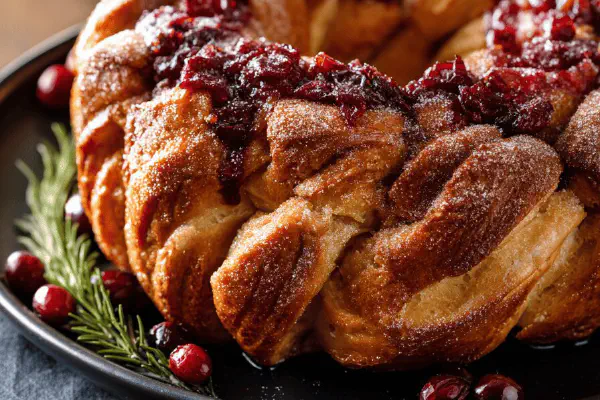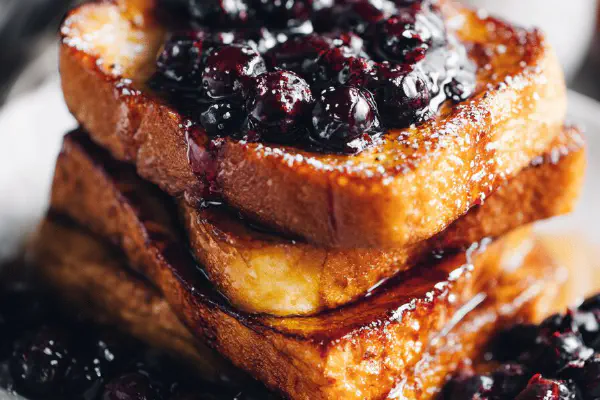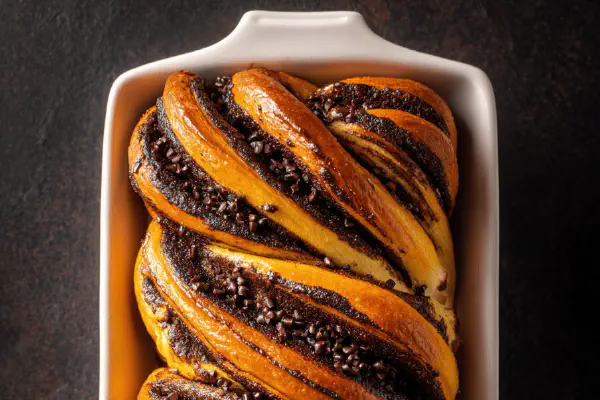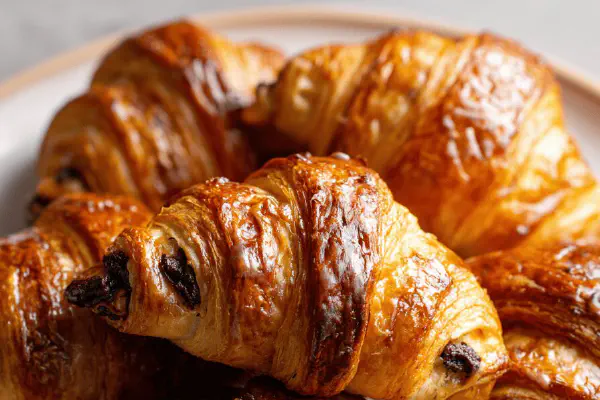Chocolate Swirl Babka
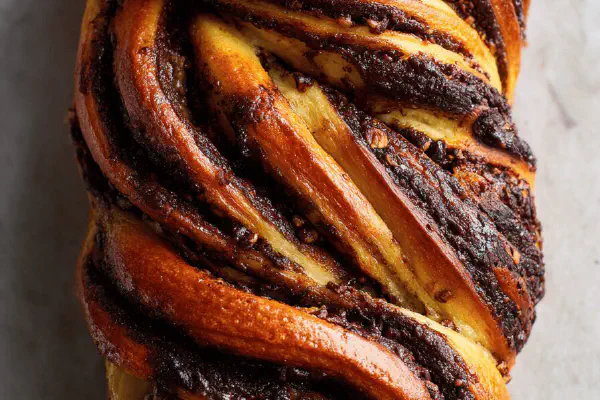
By Emma
Certified Culinary Professional
Ingredients
Dough
- 540 ml bread flour (about 2 1/4 cups)
- 1.2 ml fine sea salt (1/4 tsp)
- 140 ml almond milk, warm (a little over half cup)
- 25 ml superfine sugar (1 2/3 tbsp)
- 6 ml rapid-rise yeast (1 1/4 tsp)
- 2 large eggs plus 1 egg yolk
- 120 ml high-fat Greek yogurt
- 115 ml unsalted butter, softened, cut in pieces
Chocolate Filling
- 40 ml olive oil
- 35 ml unsweetened Dutch-process cocoa powder
- 20 ml brown rice syrup (replace corn syrup – equal measure)
- 100 ml chopped dark chocolate (70% cacao or more)
- 1 tsp ground espresso powder (optional, for depth)
Egg Wash
- 1 large egg
- 15 ml whole milk
- 5 ml vanilla extract
About the ingredients
Method
Dough
- Warm almond milk to about 38°C (100°F), not hotter—too hot kills yeast. Combine flour, salt in stand mixer bowl. Make a well in center. Pour warm milk, sprinkle sugar and yeast over top. Let sit 5 minutes, bubbles form — yeast waking up.
- Add eggs, yolk, Greek yogurt. Mix with paddle on low 2 min until shaggy dough forms. Switch to dough hook, knead on medium speed 5-6 minutes. Add softened butter cubes gradually, knead till dough feels silky, slightly sticky but pulls clean from bowl.
- Transfer dough to lightly oiled bowl. Cover tightly with plastic wrap. Find warm spot—near oven with slight heat, wrapped in kitchen towel. Let proof until doubled, roughly 1 hour 10 minutes depending on season and yeast activity.
Filling Prep
- Mix olive oil, cocoa powder, brown rice syrup, and espresso powder till smooth paste forms. No lumps. Set aside.
Assemble
- Turn dough onto floured surface. Roll into 50 x 22 cm rectangle, about 1/4 inch thick. Bright white dough contrast with dark cocoa spread.
- Spread chocolate mixture evenly, edge to edge, no missing spots. Scatter chopped chocolate over cocoa layer for texture pockets.
- Roll dough lengthwise gently but firmly, avoid squeezing air out. You want layers, not a flat roll.
- Cut roll down middle lengthwise, exposing chocolate swirls inside. Twist strands delicately, wrap ends under. You’ll get a rope with visible swirls.
- Grease 24 x 12 cm loaf pan well. Fit twisted dough inside snugly. Cover loosely with plastic. Rest and proof for 25-35 minutes or until dough rises about 3 cm over rim—not too much or it will collapse in oven.
Bake
- Preheat oven to 175°C (350°F). Mix egg, milk, vanilla. Brush gently over loaf’s surface, corners. Avoid wiping off dough’s rise.
- Place on middle rack. Bake 35-40 min. Look for deep golden crust, crackling small surface fissures. Internal temp about 91°C (195°F) if you’re precise.
- If browning too fast, tent loosely with foil last 10 min.
- Remove from oven; let cool 15 mins in pan, then transfer onto wire rack to finish cooling. Warm dough feels soft with slight spring back, aroma rich cocoa with buttery undertones.
- Slice only once fully cool or warm residual steam will squash crumb structure.
- Store wrapped in linen, keeps moist. Reheat slightly to revive softness.
Cooking tips
Chef's notes
- 💡 Milk warmed carefully to about 38 degrees not hotter. Yeast kills fast if too hot. Wait for bubbles, not just warm. Shaggy dough first, then butter added bit by bit. Kneading needs medium speed, silkiness signals right stage. Avoid chunks of butter leftover or dough won’t pull clean. Dough sticky but not sticky sticky, more like soft clingy. Proof close to oven if possible—not too warm though, or it rises weirdly. Timing depends on room, watch size not time alone.
- 💡 Chocolate filling texture matters. Olive oil keeps spreadable, no firm chocolate sheets like butter does. Mix well, no lumps. Brown rice syrup replaces corn syrup smooth sweetness without stick mess. Espresso powder optional but depth noticeable—skip if you want basic. Spread edge to edge, skips mean dry babka spots. Chopped chocolate scattered for pockets; melts variably inside, keeps texture. Rolling gently locks layers, not squished air bubbles. Roll thickness critical: too thin burns, thick clogs crumb.
- 💡 Twisting cut roll exposes swirl detail. Cut lengthwise exactly down middle, don’t off-center. Twist strands delicately. Ends tucked under to trap shape. Pan greased well—24 by 12 cm works, snug but not tight. Proof second rise just right: about 3 cm above rim. Underproofed means dense, overproofed collapses in oven—watch dough, not the clock. Rest loosely covered so crust doesn’t dry. Don’t rush proof, but don’t wait too long either.
- 💡 Egg wash with milk and vanilla adds sheen, color. Brush gently thorough crust corners, do not wipe off dough rise. Oven hot at 175 Celsius, middle rack best spot. Bake watch crust color; golden with small surface fissures means crackle. If crust browns too fast, tent foil loose last 10 minutes. Internal temp around 91 Celsius important if you have thermometer. Cool 15 minutes in pan before wire rack transfer. Cutting hot crushes crumb steam ruins ribbons.
- 💡 Store babka wrapped in linen cloth to hold moisture gently. Avoid plastic wrap long term or crust softens too much. Reheat slightly before serving, steam softens crumb but residual heat can squish if cut too soon. Rolling dough, kneading, and timing all vary by environment; dough should feel soft, elastic, slightly sticky but pulls clean. Signs more useful than clocks. Dough silence after knead means gluten developed. Crust crackle when tapped signals done.
Common questions
How to know when dough is proofed properly?
Watch size more than time. Doubled volume but also feel light, springy. Finger poke springs back slowly. Too fast or slow means temperature off. Not just rise, texture matters.
Can olive oil fully replace butter in filling?
Olive oil keeps filling moist but softer, no firm slabs like butter gives. Flavor changes slightly, earthier note. Use brown rice syrup for sweetness balance. Butter gives richer mouthfeel, olive oil smooth spread and less greasy.
Why does babka sometimes collapse in oven?
Usually overproof. Dough too airy, structure weak. Or underproof means dense crumb. Also shaped too tight or rolled too thin. Watch dough rise close near oven—not just time. Rest proof loosely covered to avoid crust drying out.
Best way to store leftover babka?
Wrap in linen or paper towel inside sealed container. Avoid plastic wrap long term or crust soggy. Refrigerate not ideal—dries crumb. Freeze sliced wrapped airtight if weeks. Reheat gently, short bursts, avoid overheating or crumb crush.
